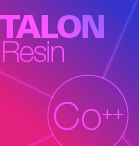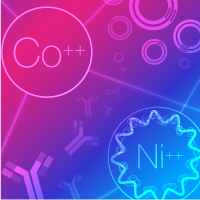FPLC purification of his-tagged proteins—TALON Superflow Metal Affinity Resin

TALON his-tag purification resin lets you prepare exceptionally pure his-tagged proteins from bacterial, mammalian, yeast, and baculovirus-infected cells, under native or denaturing conditions. TALON is an immobilized metal affinity chromatography (IMAC) resin charged with cobalt, which binds to his-tagged proteins with higher specificity than nickel-charged resins. As a result, TALON resin delivers his-tagged proteins of the highest purity. In addition, each cobalt ion is bound to the resin at four sites, resulting in low metal-ion leakage.
TALON his-tag purification resin lets you prepare exceptionally pure his-tagged proteins from bacterial, mammalian, yeast, and baculovirus-infected cells, under native or denaturing conditions. TALON is an immobilized metal affinity chromatography (IMAC) resin charged with cobalt, which binds to his-tagged proteins with higher specificity than nickel-charged resins. As a result, TALON resin delivers his-tagged proteins of the highest purity. In addition, each cobalt ion is bound to the resin at four sites, resulting in low metal-ion leakage.
Reactive core contains cobalt for highest purity
TALON Superflow Metal Affinity Resin is complexed with cobalt ions that make it highly selective for his-tagged proteins. TALON’s cobalt-containing reactive core has strict spatial requirements—only proteins containing adjacent histidines or specially positioned, neighboring histidines are able to bind. The spatial requirements for nickel-based resins (e.g., Ni-NTA) are less strict—these resins have a much higher affinity for randomly positioned (i.e., non-his-tag) histidines. As a result, TALON resin binds more specifically to his-tagged proteins.
TALON Superflow Metal Affinity Resin is specifically designed for quick and effective purification of his-tagged proteins at high flow rates and medium pressure (up to 150 psi)—it’s ideal for FPLC applications. For prepacked 1 ml and 5 ml cartridges, please see the HisTALON Superflow Cartridge product page.
Uniform matrix guarantees less contamination
Cobalt-based resins have a more uniform structure than nickel-based resins. TALON resin contains negatively charged reactive sites that form three-dimensional pockets. Each pocket contains three carboxyl groups and one nitrogen atom that collectively bind a single, positively charged cobalt ion—an arrangement that allows the cobalt ion to bind to two adjacent histidine residues. In this configuration, cobalt is bound very tightly and does not leach out of the resin. Nickel-based resins are less homogeneous in structure because nickel ions can form two different coordination complexes: one of which forms a three-dimensional pocket similar to that of the TALON ligand, and a second that forms a planar (flat) structure. In the distorted, planar structure, each nickel ion binds to only two carboxyl groups and one nitrogen atom. As a result, the planar structure binds the nickel ions less tightly, allowing them to leach from the resin. TALON Metal Affinity Resin, with its uniform matrix, provides high affinity binding under a variety of purification conditions, ensuring optimal protein purification.
Overview
Choice of native or denaturing purification conditions
TALON Resin retains its protein binding specificity and yield under a variety of purification conditions. It is stable under both denaturing and native (nondenaturing) conditions. Deciding whether to use native or denaturing purification conditions depends on protein location, solubility, accessibility of the his tag, downstream applications, and preservation of biological activity.
-
Native conditions
Purifying a protein under native conditions is the most efficient way to preserve its biological activity, but requires that the protein be soluble. Advantages include:
- Eliminating the renaturation step at the end of the purification, saving time, and preventing significant loss of activity
- Retaining the ability to copurify enzyme subunits, cofactors, and associated proteins
-
Denaturing conditions
Because proteins that are overexpressed in prokaryotic systems sometimes form insoluble aggregates called inclusion bodies, you may need to purify proteins under denaturing conditions—using strong denaturants such as 6 M guanidinium or 8 M urea to enhance protein solubility. Advantages include:
- Complete solubilization of inclusion bodies and his-tagged proteins
- Improved binding to the matrix and reduced nonspecific binding, due to full exposure of the his tag
Use of reducing agents
Purification with TALON resin may be carried out in the presence of β-mercaptoethanol, but not DTT or DTE, to preserve reduced sulfhydryl (-SH) groups that are important for the biological activity and structure of a given protein. TALON provides higher yields than Ni-NTA in the presence of β-mercaptoethanol.
More Information
Features
- Exhibits high affinity for his-tagged proteins
- Ideal for FPLC applications
- No copurification of proteins
- Resists metal leakage
- Performs well under a wide range of purification conditions
Applications
Purified recombinant his-tagged proteins can be used for:
- Crystallography
- Functional assays
- Structural investigations
- Other applications
Additional product information
Please see the product's Certificate of Analysis for information about storage conditions, product components, and technical specifications. Please see the Kit Components List to determine kit components. Certificates of Analysis and Kit Components Lists are located under the Documents tab.
Takara Bio USA, Inc.
United States/Canada: +1.800.662.2566 • Asia Pacific: +1.650.919.7300 • Europe: +33.(0)1.3904.6880 • Japan: +81.(0)77.565.6999
FOR RESEARCH USE ONLY. NOT FOR USE IN DIAGNOSTIC PROCEDURES. © 2025 Takara Bio Inc. All Rights Reserved. All trademarks are the property of Takara Bio Inc. or its affiliate(s) in the U.S. and/or other countries or their respective owners. Certain trademarks may not be registered in all jurisdictions. Additional product, intellectual property, and restricted use information is available at takarabio.com.




